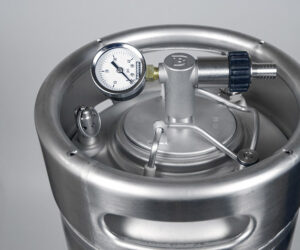Using Quick-Souring Yeasts: Tips from the Pros
Novel yeast strains that have been released to brewers in recent years do the job of souring and fermenting on their own, cutting down on the required steps and time it takes to brew sour beers. Three pro brewers share their experiences and advice for homebrewers curious to give them a try.
Lionel Navarro is the Head Brewer at HopEra Microbrasserie & Pizzeria in Jonquière, Quebec

I’ve tried a lot of different souring methods as a pro brewer, but also as a homebrewer. My souring exploration began with the use of probiotics capsules from the drugstore, which is an easy and reliable way to pitch a pure culture of Lactobacillus at low cost. I’ve also tried mash and kettle souring methods using a handful of crushed grains in order to experiment with a more “traditional” approach. It is cheaper than the probiotics but it is a little riskier as the grains contain a lot of different organisms. Another method is to use a souring blend of Lactobacillus and wild yeast to pitch in the fermenter and allow time to do its magic; it is more expensive and you have a little less control on the outcome, but it is definitely a lot of fun!
Totally different from these methods is using WildBrew Philly Sour, which is a different genus — Lachancea spp.,not the Saccharomyces cerevisiae yeasts we are used to fermenting with. We use Philly Sour for our PupTart brand, a series of fruited Berliner weisses, which has greatly simplified the production schedule. As we produce a lot of different sour beers in a very small brewery with limited equipment, it is challenging to make a kettle sour (where Lactobacillus is used to sour wort over the course of a day or two prior to fermentation) in addition to any other task in the brewery (cleaning a fermenter, transferring a beer, etc.). With quick-souring yeast, making a sour beer takes basically the same time as a regular beer while also freeing up equipment for other brews.
The first time I used Philly Sour I was very surprised with the result. It is a much slower fermenting yeast and the lag phase before you can actually measure attenuation is much longer considering that the yeast produces lactic acid prior to degrading sugars. When I use Philly Sour I tend to ferment my beer at higher temperatures — around 73–77 °F (23–25 °C) to insure a healthy fermentation. I usually reach my final gravity in 10–14 days. I found that the final pH is closely related to the amount of fermentable sugars, which is impacted by the mash temperature. Final pH was the trickiest parameter to adjust using Philly Sour and the first time I used it I got pH as low as 2.4 (I was making super dry sour beers)! Mashing around 154–157 °F (68–69 °C) allows me to reach more palatable pH values around 3.2.
Once you have domesticated the yeast and understand how to use it, it is possible to produce constant results similar to other souring methods. That said, I believe there is definitely less control using quick-souring yeast, especially concerning final pH adjustment. Philly Sour suits our need for the quick production of our thirst quenching PupTarts, but we still use kettle souring or traditional souring to produce special products that need a special yeast signature, a higher pH, or a particularly dry beer.
Philly Sour is particularly well suited for fruited beers as a little residual sugar helps reconstruct the taste of a juicy, well-ripe fruit. I’d still recommend kettle souring to the brewers who like to fine-tune every aspect of their beers.
I think homebrewers and especially beginners have the most to gain from quick-souring yeasts. Kettle souring implies you have the ability to maintain a certain temperature during the entire souring period, which I think discourages most beginners from brewing sour beers. Don’t be afraid to experiment with these quick-souring yeasts. You may need a few attempts to get the result you want but you will learn a lot in the process.
Zach Kelly is the Brewmaster of HenHouse Brewing Company in Santa Rosa, California

I would never discount traditional sours, which have a complexity to them that cannot be replicated easily, but I think fruited Goses and salted Goses are great with quick souring methods. They are highly drinkable and, from a consumer standpoint, they tend to be a great entry-level sour. Using a blend of fruits is something that really lets these quick sour beers shine.
At HenHouse, we’ve landed on Sourvisiae as our primary quick-souring yeast strain. We’ve also done some fermentations with Berkeley Yeast’s Galactic. The thing that we have noticed is that Galactic will generally finish around pH 3.3–3.5, whereas Sourvisiae on its own will finish around pH 3.0. Our Sourvisiae ferments are usually for lower-ABV fruited Goses. We aim for a starting gravity at about 1.040, and look to finish at about 1.010. When using Sourvisiae we do co-ferments with Imperial’s Flagship yeast (the Chico strain) at a ratio of 30% Flagship to 70% Sourvisiae. Doing this allows us to control our finishing pH to a range closer to 3.3. That is pretty much our “sweet spot,” but will adjust +/- 10% or so if we are using a particularly acidic fruit like lime, where a higher ratio of Flagship-to-Sourvisiae will keep a more balanced mouthfeel without being overly sour. We knock out at 72 °F (22 °C) and fruit these beers 2–3 days into fermentation. This allows the fruit sugars to fully ferment out and mitigates the risk of compromised cans.
Once you start to get a feel for the yeast I believe there is more control in Sourvisiae over kettle souring. On a production scale, there are too many factors that can change a kettle sour’s profile. I’ve found them to be too finicky and often end up needing far more effort to execute properly.
The biggest benefit to these souring yeasts are reliability, repeatability, and mitigating the use of Lactobacillus. Especially if you are primarily a clean brewery, or don’t have the luxury of dedicated sour equipment. The peace of mind in itself is a huge benefit.
Tim Floros is a founding member, President, and Brewmaster of Levante Brewing Company in West Chester, Pennsylvania

The obvious benefits to using a quick-souring yeast are time and labor savings as well as quality assurance within the brewery. For example, kettle souring ties up the brew kettle for 1–2 days, which can be a costly alternative to using equipment for core product lines such as clean ales and lagers. From a quality perspective, bringing in bacteria like Lactobacillus and Pediococcus can invite bacterial infection in brewing equipment.
We have been using WildBrew Philly Sour for the past few years, which has been a wild trial and error process that’s taught us a ton about the nuances and flavors derived from fermentation and co-fermentation. From a sensory perspective, Philly Sour provides a sour note that’s more robust and fruitier than other methods of quick souring, and the overall depth of flavor is noticeably more complex and enjoyable.
We’ve found Philly Sour to be extremely versatile. We use it in fruited sours, dry-hopped sours, tart Gose-style beers, cocktail-inspired beers, and have recently used it in a “pickle Pilsner.” We’ve even incorporated Philly Sour into our pizza dough fermentation. The time, temperature, and pH all vary depending on the exact results we’re looking for from the yeast, such as attenuation, degree of an acidity/lactic acid production, how much orchard fruit characteristic such as peach and apple that we’re looking for, etc. We can then decide if we’ll need to co-pitch a partner yeast strain to fulfill other characteristic requirements for the beer we’re making. For example, if we want to end up with a low pH and high lactic acid production for a fruited sour, we’ll usually ferment at 68–70 °F (20–21 °C) for 1–2 weeks and opt not to co-pitch. This produces a fantastic sour in less time and with less work than other methods.
Philly Sour is also vastly more versatile than other methods when it comes to alcohol- and hop-tolerance as well as lactic acid production. It’s important to monitor the fermentation metrics and sensory profile of the fermentation because the pH changes from acid production are typically occurring in a tight time frame (the first 2–3 days of primary fermentation). It’s nothing to be afraid of, it’s just different than other methods because it’s an organism we hadn’t worked with before.



